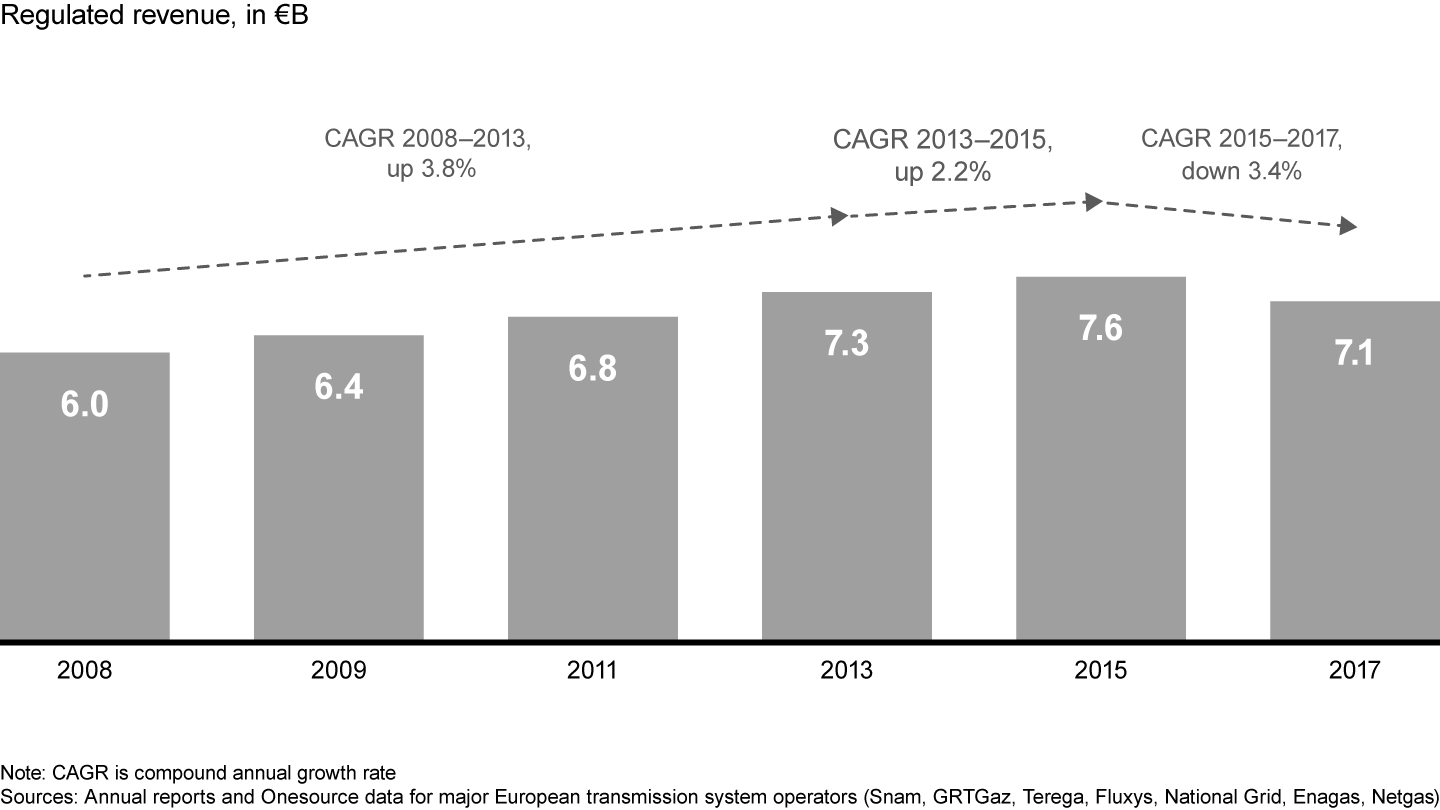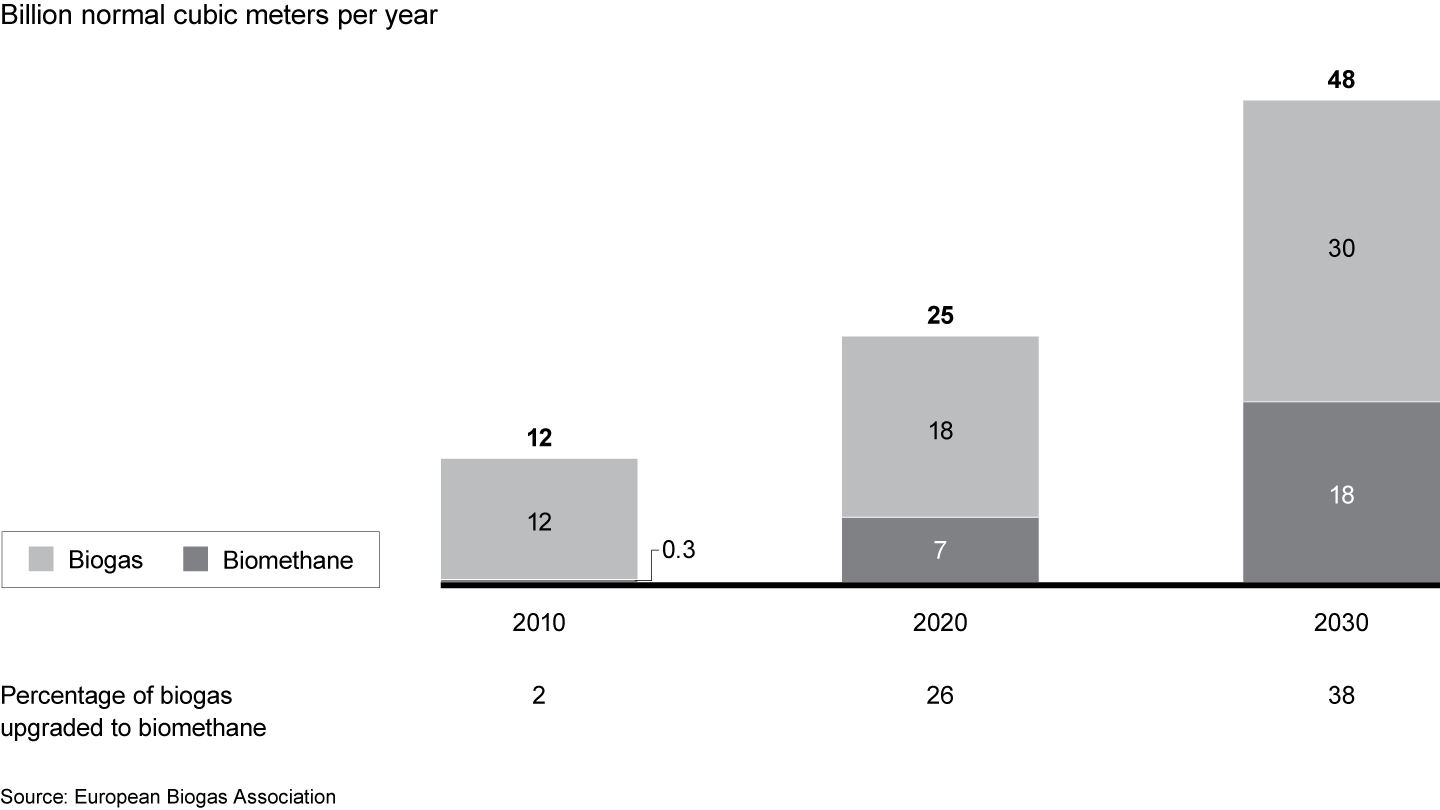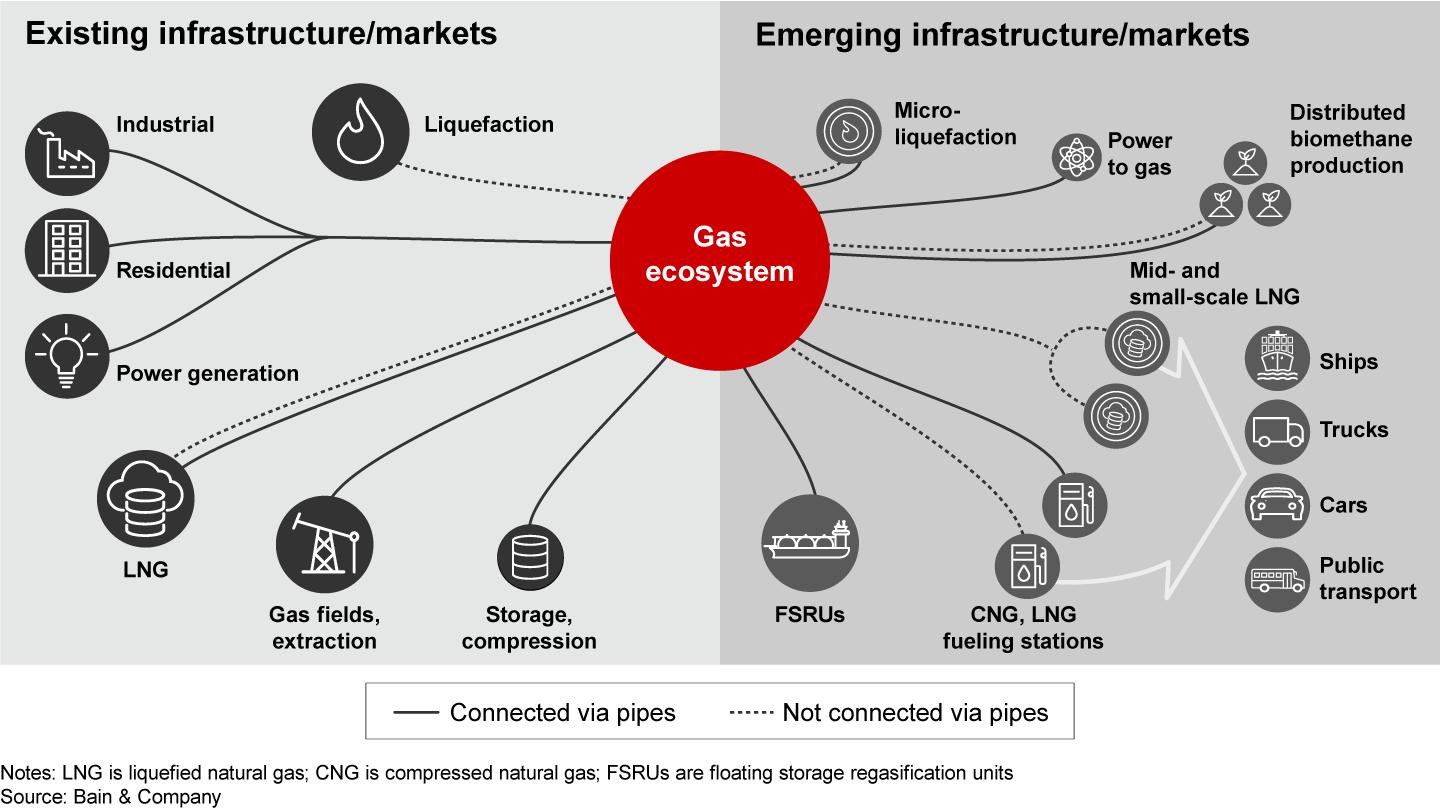Brief

Executive Summary
- Europe's natural gas market is being reshaped by decarbonization, the rise of renewable energy sources, the greening of the transportation sector and an increase in imported liquefied natural gas.
- To make the most of these opportunities, transmission system operators will redefine and expand the scope of their role, becoming enablers of new growth and learning how to work with new technologies and serve emerging market segments.
- Some new opportunities will appear in unregulated businesses, so transmission system operators will need to improve the ways they assess opportunities, measure economic potential and facilitate investment in the evolving infrastructure.
As the market for midstream gas infrastructure in Europe approaches maturity, several powerful trends are converging to complicate what could otherwise be a straightforward business. In recent years, capital investment and remuneration rates for Europe’s transmission system operators (TSOs) have dipped, limiting the potential for growth in the largely regulated world of European midstream. But decarbonization and the broad energy transition that industries and consumers will undergo to achieve it could have a dramatic effect on the core business of TSOs, creating opportunities in infrastructure development and adjacencies.
To take advantage of these new opportunities and thrive, midstream executives will need to redesign their business and operating models and develop new capabilities. The new environment poses numerous challenges.
- Consumption of natural gas in Europe declined by 10% between 2008 and 2017. Despite the partial recovery over the past three years, demand for gas is structurally lower than it was 10 years ago, due to the impact of the economic crisis and the rise of renewable energy sources. Most scenarios forecast nearly flat growth over the next 10 years.
- National regulators are reducing incentives for infrastructure development and tightening returns, which has caused remuneration rates to decline by 1.5% from 2013 to 2017.
- Consequently, major midstream companies’ capital investments decreased from €3 billion per year in the 2008–2013 five-year period to €2.4 billion per year in 2013–2017.
- Regulated revenue growth is also slowing, from a 3.8% compound annual growth rate in 2008–2013 to 2.2% in 2013–2015. More recently, revenue actually declined by 3.4% in 2015–2017 (see Figure 1).
- Regulators are asking for more efficiency from asset management, and midstreamers have already cut general and administrative costs and operations significantly in recent years. Further efficiency will come from digital transformation, which is already having an effect on the midstream gas infrastructure industry, improving the productivity of field operations, increasing safety and optimizing the grid’s efficiency.
Several underlying trends in Europe’s gas market will expand opportunities in midstream development.
- Rising demand for efficiently functioning markets as more gas exchanges between markets will require the development of new interconnection pipelines between markets.
- More imported gas could necessitate the development of storage services to ensure adequate security of supply.
- A shift from northern to southern routes, such as the Trans Adriatic Pipeline across Greece to Italy, will require new infrastructure.


At the same time, other forces are generating new opportunities for midstream companies in Europe, creating new markets in storage and distribution.
Decarbonization: The EU has set greenhouse gas targets that would reduce emissions by as much as 95% compared with 1990 levels, starting with a 20% reduction by 2020. The speed of this transition will vary from one region to another, but the trend is clear.
The greening of the transportation sector will produce more vehicles running on more types of fuel, including bio-compressed natural gas and bio-liquefied natural gas. Fuels derived from natural gas will power heavy-duty vehicles, maritime transport and trains. And regulatory incentives will stimulate the biofuels industry. The European Natural Gas Vehicle Association (NGVA) expects a 10% market share for passenger cars running on natural gas by 2030, a tenfold increase above the 1.3 million vehicles today. Market share could be even higher for trucks (20%–25%) and buses (30%).
To supply these vehicles, compressed natural gas and liquefied natural gas fueling stations will proliferate (CNG stations for cars, LNG for medium- and heavy-duty vehicles). Several projects to develop more natural gas fueling stations are underway across Europe. Based on national policies, NGVA forecasts more than 2,500 new CNG stations and about 300 new LNG stations by 2025, amounting to about €850 million of capex. Similarly, mid- and small-scale LNG assets, such as microliquefactions or coastal deposits, will need to be developed to supply road and maritime transports, amounting to another €945 million of capex for LNG infrastructures in seaports by 2025.
Development of renewable sources of natural gas, especially biomethane from biomass (organic waste, agricultural biomass), requires new infrastructure to carry gas from its production source to distribution (see Figure 2). While pipelined natural gas and imported LNG are likely to remain the dominant sources of supply, the potential for biomethane production could reach about 20 billion cubic meters by 2030. This rise in renewable gas production will require the connection of thousands of small-volume biomethane plants to the natural gas grid, at an investment of around €40 billion.
Emerging technologies to increase flexibility of energy supply: Large-scale storage solutions become increasingly important as intermittent renewable resources contribute more power to the grid. Power to gas, the process of converting surplus renewable energy into hydrogen gas by rapid-response electrolysis and its subsequent injection into the gas distribution network, can play a role along with batteries to manage various energy storage needs.


Seizing new opportunities
While the essence of the midstream business will remain the same—namely, connecting supply with demand through the development, operation and maintenance of infrastructure—a changing landscape creates new opportunities for TSOs (see Figure 3). The energy transition will expand the traditional scope of midstream infrastructure, from biomethane plants upstream to natural gas fueling stations and small-scale LNG assets downstream. Decarbonization promises to boost consumption of natural gas, leading to more capital investment that will sustain midstream’s core infrastructure business.


However, TSOs will need to adapt their roles and develop new models to capture the value inherent in these changes.
Redefine the role. Midstream’s new, green ecosystem is complex and requires the contribution of many different actors, including oil and gas retailers, automakers, utilities, shipping and logistics companies, agricultural companies and others. At the center of it all, TSOs will assume a new role as enablers of system growth, helping to stimulate demand, support regulations, develop emerging market segments and unlock investments. To help redefine their role, executives should consider several questions:
- Who are the key stakeholders in the green ecosystem, and what is their role?
- What are the major costs and benefits for each stakeholder in this transition?
- Is capex available to enable the transition, or is there a bottleneck in investment?
Some European TSOs are already participating in upstream (biomethane plants) and downstream (CNG/LNG fueling stations, microliquefactions) infrastructure by acting as catalysts and securing investments. The full scope of this role entails working with automakers to improve their natural gas vehicles, as well as working with major oil and gas retailers to support the expansion of a natural gas fueling station network.
Develop new business models. Midstreamers will need to adopt new business models for new markets, some of which may not be regulated. Executives will want to evaluate the technical and economic feasibility of each, developing specific business cases and undertaking cost benefit analyses. Several key questions can help them shape the proper business model:
- How much value is there in the development of a certain piece of infrastructure, and what is necessary to extract that value?
- Can you control the model on your own, or is a partnership more suitable?
- Are there any regulatory constraints?
- What is the volume risk for the new assets? Would it be more reasonable to extend the regulated infrastructural scope to manage this risk? In this case, would the regulated model be fast enough to enable the transition?
In developing these new assets, TSOs should define business models that share risks and rewards with partners, taking into consideration the capabilities and competencies of each stakeholder in the value chain. For example, ensuring the feedstock supply of biomethane plants or achieving target utilization rates of fueling stations both require specific market competencies. Joint ventures with feedstock producers are a promising way to manage the former. For the latter, TSOs could consider establishing tolling business models to develop assets and then rent them to oil and gas retailers with variable tolling fees in order to share the risk volume during the ramp-up.
Understand the new competitive landscape. New actors will participate in the midstream landscape, defining new competitive dynamics, especially in infrastructural adjacencies such as biomethane plants and compression stations. Depending on the business model, oil and gas companies, agricultural interests and utilities could be either partners or competitors. Key questions to help manage competition:
- Who are the competitors in each new infrastructural segment of the value chain?
- Are competitors vertically integrated in the value chain?
- Who are the potential suppliers and customers for the operators of the new assets?
- Which segment of the value chain controls value?
- How do you manage supply and market risks in a new competitive environment—that is, assuming this isn’t a regulated model?
Upstream, the most relevant item of value is the availability of feedstock for biomethane production, so agricultural and utility companies are best positioned to control supply flows. TSOs can work through joint ventures or strong contractual agreements to define the ground rules of feedstock supply. Downstream, oil and gas retailers already control distribution networks of fueling stations. TSOs could either collaborate with them to bring CNG/LNG pumps into the network or set up their own fueling stations. Alternatively, they could work with automakers and municipalities to develop dedicated fueling stations and fleets of CNG/LNG buses and waste collection vehicles.
Carefully adjust the risk-reward profile. The emerging opportunities and competitive landscape will challenge midstream’s traditional regulation-based risk-reward profile. Executives will want to assess and define risk-reward curves as they move into new businesses. Crucial questions:
- What is the acceptable risk-reward profile for a TSO in the new businesses?
- What are the key risk factors for each new segment of the value chain?
- What levers control these risk factors, and what contractual items need to be defined to manage them?
Adopting a proactive stance with scenario modeling can help TSOs define the context and market evolution. Ongoing monitoring of key signposts will help them identify market direction and adapt to the pace of transformation. New investments in infrastructure should be driven by market opportunities, and the risks should be assessed carefully to avoid stranded assets, especially in nonregulated business models.
Develop new operating models. New businesses and markets will require entirely new operating models, not just modifications of existing ones. These models will be necessary to manage new assets and technologies while meeting the business demands of rapid time to market and flexibility. Important questions:
- What processes and activities need to be set up or revised to enter new value chain segments?
- What are the related success factors?
- Which existing capabilities can be leveraged, and what are the potential gaps that need to be addressed with either a make or buy model?
For example, TSOs venturing into nonregulated business models for the first time will have to raise their customer engagement skills. Meeting consumer demands for rapid time to market and flexibility will challenge existing core processes from procurement to sales. Traditionally structured and bureaucratic processes will need to be completely revised following a more Agile approach.
Expand human capital skills. TSOs will need people with different capabilities. In particular, talent with strong engineering, procurement and construction (EPC) skills will be required to acquire and operate different kinds of assets, including biomethane plants and CNG fueling stations. Midstreamers will also want to strengthen their commercial skills in order to develop the wider customer portfolio required to expand new business lines. Among the questions to help discern the starting point:
- What skills are necessary to manage new internal processes?
- Are the required resources already available in the company?
- What is the best approach to acquire additional resources—focused hires, acquisitions or some combination?
- Should talent management policies be revised to thrive in the new environment?
Change the culture. Finally, new business opportunities will disrupt the traditional culture of TSOs. Customer engagement and rapid time to market will become increasingly important, particularly in unregulated businesses. Successful companies will encourage a start-up mentality, supporting entrepreneurialism and a trial-by-error approach over more structured processes. Important questions:
- What core values need to be shared across the organization to enable the transition?
- How will these values reshape priorities and perspectives?
- Do the existing organizational structures support the new environment or should they be adapted?
- What is the appropriate change management program to drive the transition?
Continuous innovation will help companies develop greener and more efficient technologies, which will be keys to success in these markets. Executive teams will want to focus on simplifying the organization, nurturing innovation and partnering with venture capital firms.
Future developments in the evolution of the energy landscape, including the rising importance of hydrogen and power-to-gas technologies, as well as the sequestration of carbon dioxide, will continue to create new challenges for the midstream value chain. Whatever the real market implications of these and other disruptive innovations may be, TSOs will continue to play a central role.
Andrea Isabella and Roberto Nava are Bain partners in Milan, working with the Global Energy & Natural Resources practice.
The authors would like to thank Mattia Bernardi for his contributions to this work.